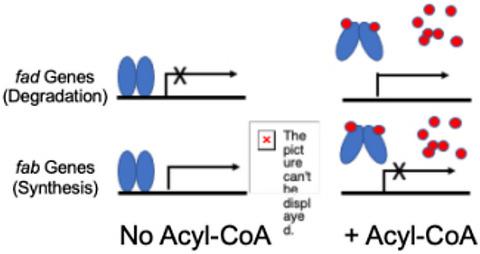当前位置:
X-MOL 学术
›
Mol. Microbiol.
›
论文详情
Our official English website, www.x-mol.net, welcomes your
feedback! (Note: you will need to create a separate account there.)
The Escherichia coli FadR transcription factor: Too much of a good thing?
Molecular Microbiology ( IF 2.6 ) Pub Date : 2020-12-07 , DOI: 10.1111/mmi.14663 John E Cronan 1
Molecular Microbiology ( IF 2.6 ) Pub Date : 2020-12-07 , DOI: 10.1111/mmi.14663 John E Cronan 1
Affiliation

|
Escherichia coli FadR is a transcription factor regulated by acyl-CoA thioester binding that optimizes fatty acid (FA) metabolism in response to environmental FAs. FadR represses the fad genes of FA degradation (β-oxidation) and activates the fab genes of FA synthesis thereby allowing E. coli to have its cake (acyl chains for phospholipid synthesis) and eat it (degrade acyl chains to acetyl-CoA). Acyl-CoA binding of FadR derepresses the transcription of the fad genes and cancels fab gene transcriptional activation. Activation of fab genes was thought restricted to the fabA and fabB genes of unsaturated FA synthesis, but FadR overproduction markedly increases yields of all FA acyl chains. Subsequently, almost all of the remaining fab genes were shown to be transcriptionally activated by FadR binding, but binding was very weak. Why are the low-affinity sites retained? What effects on cell physiology would result from their conversion to high-affinity sites (thereby mimicking FadR overproduction)? Investigations of E. coli cell size determinants showed that FA synthesis primarily determines E. coli cell size. Upon modest induction of FadR, cell size increases, but at the cost of growth rate and accumulation of intracellular membranes. Greater induction resulted in further growth rate decreases and abnormal cells. Hence, too much FadR is bad. FadR is extraordinarily conserved in γ-proteobacteria but has migrated. Mycobacterium tuberculosis encodes FadR orthologs one of which is functional in E. coli. Strikingly, the FadR theme of acyl-CoA-dependent transcriptional regulation is found in a different transcription factor family where two Bacillus species plus bacterial and archaeal thermophiles contain related proteins of similar function.
中文翻译:

大肠杆菌 FadR 转录因子:太好了?
大肠杆菌FadR 是一种受酰基辅酶 A 硫酯结合调节的转录因子,可优化脂肪酸 (FA) 代谢以响应环境 FA。FadR 抑制FA 降解(β-氧化)的fad基因并激活FA 合成的fab基因,从而使大肠杆菌有它的蛋糕(用于磷脂合成的酰基链)并吃掉它(将酰基链降解为乙酰辅酶 A)。FadR 的酰基辅酶A 结合解除抑制fad基因的转录并取消fab基因的转录激活。fab基因的激活被认为仅限于fabA和fabB不饱和 FA 合成的基因,但 FadR 过量生产显着增加了所有 FA 酰基链的产量。随后,几乎所有剩余的fab基因都显示出被 FadR 结合转录激活,但结合非常弱。为什么低亲和力网站会被保留?它们转化为高亲和力位点(从而模仿 FadR 过度生产)会对细胞生理学产生什么影响?对大肠杆菌细胞大小决定因素的研究表明,FA 合成主要决定了大肠杆菌细胞大小。在适度诱导 FadR 后,细胞大小会增加,但以细胞内膜的生长速度和积累为代价。更大的诱导导致进一步的生长速率降低和异常细胞。因此,过多的 FadR 是不好的。FadR 在 γ-proteobacteria 中非常保守,但已经迁移。结核分枝杆菌编码 FadR 直向同源物,其中之一在大肠杆菌中起作用。引人注目的是,在不同的转录因子家族中发现了依赖于酰基辅酶 A 的转录调控的 FadR 主题,其中两种芽孢杆菌属以及细菌和古细菌嗜热菌含有类似功能的相关蛋白质。
更新日期:2020-12-07
中文翻译:

大肠杆菌 FadR 转录因子:太好了?
大肠杆菌FadR 是一种受酰基辅酶 A 硫酯结合调节的转录因子,可优化脂肪酸 (FA) 代谢以响应环境 FA。FadR 抑制FA 降解(β-氧化)的fad基因并激活FA 合成的fab基因,从而使大肠杆菌有它的蛋糕(用于磷脂合成的酰基链)并吃掉它(将酰基链降解为乙酰辅酶 A)。FadR 的酰基辅酶A 结合解除抑制fad基因的转录并取消fab基因的转录激活。fab基因的激活被认为仅限于fabA和fabB不饱和 FA 合成的基因,但 FadR 过量生产显着增加了所有 FA 酰基链的产量。随后,几乎所有剩余的fab基因都显示出被 FadR 结合转录激活,但结合非常弱。为什么低亲和力网站会被保留?它们转化为高亲和力位点(从而模仿 FadR 过度生产)会对细胞生理学产生什么影响?对大肠杆菌细胞大小决定因素的研究表明,FA 合成主要决定了大肠杆菌细胞大小。在适度诱导 FadR 后,细胞大小会增加,但以细胞内膜的生长速度和积累为代价。更大的诱导导致进一步的生长速率降低和异常细胞。因此,过多的 FadR 是不好的。FadR 在 γ-proteobacteria 中非常保守,但已经迁移。结核分枝杆菌编码 FadR 直向同源物,其中之一在大肠杆菌中起作用。引人注目的是,在不同的转录因子家族中发现了依赖于酰基辅酶 A 的转录调控的 FadR 主题,其中两种芽孢杆菌属以及细菌和古细菌嗜热菌含有类似功能的相关蛋白质。











































 京公网安备 11010802027423号
京公网安备 11010802027423号